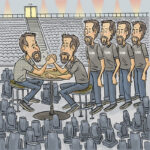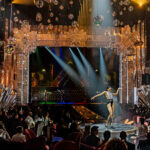The 1950s was also the era of those ubiquitous anaglyph glasses — the ones with red and cyan lenses. The films were created using two superimposed contrasting colored filters (one for each eye), and the colors were offset laterally to create depth. When the film is projected, the anaglyph glasses separate the left and right images by canceling out the filter colors, and your brain does the rest by putting the stereoscopic illusion together. The technique is still in use today on a very small scale, because new technologies have taken over the task. But back then, synchronizing two mechanical projectors was difficult. Enter digital cinema, and one of the major hurdles fell away. Dual projector synchronization was suddenly moot, because based on server playback, you simply feed two digital projectors from one source, and there’s nothing mechanical to get in the way.
From “Video World” by Paul Berliner, PLSN, Oct. 2009


